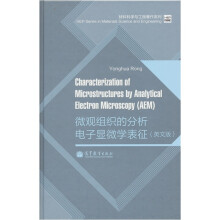Chapter 1 Analytical Electron Microscope (AEM)
1.1 Brief introduction of AEM history
1.2 Interaction between electrons and specimen and signals used by AEM
1.3 Electron wavelength and electromagnetic lens
1.3.1 Electron wavelength
1.3.2 Electromagnetic lens
1.4 Structure and function of AEM
1.4.1 Illumination system
1.4.2 Specimen holders
1.4.3 Imaging system
1.4.4 Image recording
1.4.5 Power supply system and vacuum system
1.4.6 Computer control '
1.5 The principle of imaging, magnifying and diffracting
1.6 Theoretical resolution limit
1.7 Depth of focus and depth of field
1.8 Spherical aberration-c0rrected TEMs References
Chapter 2 Specimen Preparation
2.1 Traditional techniques
2.1.1 Replica
2.1.2 Preparation of powders
2.1.3 Film preparation for plan view
2.1.4 Film preparation from a bulk metallic sample .
2.1.5 Film preparation from a bulk nonmetaltic sample.
2.2 Special techniques
2.2.1 Cross-sectional specimen preparation
2.2.2 Cleaving and small angle cleavage technique
2.2.3 Ultramicrotomy
2.2.4 Focused ion beam technique References
Chapter 3 Electron Diffraction
3.1 Comparison of electron diffraction with X-ray diffraction
3.2 Conditions of diffraction
3.2.1 Geometric condition
3.2.2 Physical condition
3.2.3 Diffraction deviating from exact Bragg Condition
3.3 Basic equation used for analysis of electron diffraction pattern
3.3.1 Diffraction in an electron diffractometer
3.3.2 Diffraction in a TEM
3.4 Principle and operation of selected area electron diffraction
3.5 Rotation of image relative to diffraction pattern
3.6 Diffraction patterns of polycrystal and their applications
3.6.1 Formation and geometric features of diffraction patterns for polycrystal
3.6.2 Applications of ring patterns
3.7 Geometric features of diffraction patterns of single crystals
3.7.1 Geometric features and diffraction intensity of a single crystal pattern
3.7.2 Indexing methods of single crystal diffraction patterns
3.8 Main applications of single crystal pattern
3.8.1 Identification of phases
3.8.2 Determination of orientation relationship
3.9 Diffraction spot shift by stacking faults and determination of stacking fault probability
3.9.1 Diffraction from planar defect
3.9.2 Determination of stacking fault probability in HCP crystal
3.9.3 Determination of stacking fault probability in FCC crystal
3.10 Systematic tilting technique and its applications
3.10.1 Systematic tilting technique by double tilt holder.
3.10.2 Determination of electron beam direction
……
Chapter 4 Mathematics Analysis in Electron Diffraction and Crystallography
Chapter 5 Diffraction Contrast
Chapter 6 high Resolution and High Spatial Resolution of Analytica electron Microscopy
Appendix
Index

 缺书网
缺书网 扫码进群
扫码进群







